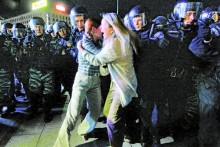This has been illustrated by the data received from protests monitoring conducted by the Center for Society Research in January-September 2013 in the framework of the Ukrainian Protest and Coercion Data Project. “In the first nine months of this year already 333 protest events related directly to the issue of arbitrariness or inaction of law-enforcement agencies have been recorded. These protests constituted 12 percent of all protest events during this period. Such number of protest events against the Ukrainian law-enforcement system hasn’t been observed in previous years. This year, the number of protests as of September is already 25 percent higher than it was for the entire 2012 and several times higher than in 2010 and 2011,” reads the report made by the Center for Society Research.
The main wave of discontent this year occurred after the events that took place in Vradiivka, Mykolaiv oblast in July. Two police officers were accused of beating and raping a local resident. The previous waves of similar protests were half as intense. The reasons for such protests were the death of a university student Ihor Indylo in Kyiv police station in June 2010, detention of activists of rightwing organizations in connection with the destruction of the monument to Joseph Stalin in Zaporizhia in January 2011, and the rape and attempted murder of a resident of Mykolaiv Oksana Makar in March 2012.
In September this year journalists and social activists in many cities of Ukraine also protested against police inaction in investigating the case and looking for the master minds of the murder of Heorhii Gongadze. Protests were also held because of what happened to the Ukrainian fishermen, who were attacked by Russian border guards in the Azov Sea. The press release of the Center for Society Research stresses that in protesting against the inaction or arbitrariness of police officers Ukrainians are rarely using confrontational or violent tactics. Since the beginning of 2013 only four percent of these protests were violent, compared with seven percent of the total number of protests. Only in 15 percent of the cases protesters used nonviolent but confrontational tactics, compared with 19 percent of all protests.
COMMENTARY
Volodymyr ISHCHENKO, sociologist, supervisor of the Ukrainian Protest and Coercion Data project conducted by the Center for Society Research, senior lecturer at the Department of Sociology (National University Kyiv Mohyla Academy), co-editor of the magazine of social criticism Spilne:
“If we would analyze the results of the monitoring project, more protests were held against police arbitrariness, and fewer protests were held against the inaction of law-enforcement bodies. To predict whether the number of protests will increase in the future we have to consider two factors. First is whether the law-enforcement system will be reformed. If it won’t be reformed, such protests as the ones that took place in Vradiivka will be held in other places. Besides, Vradiivka is also far from being unique, just for some reason it provoked a great response. Similar cases of tyranny, perhaps, not such rapes, but rather various violations of the law committed by police officers, are happening in large numbers throughout Ukraine. The second factor is the political situation. The situation in Vradiivka was used by the opposition and further developed into a campaign, a march to Kyiv and ultimately led to a large number of solidarity protests with Vradiivka residents in many Ukrainian cities.
“In general, this statistics show that the problems of law-enforcement system remain unsolved, at least not drastically. All attempts to punish someone, to release or dismiss someone are only some individual changes that do not change the fact that the law-enforcement system in Ukraine is transferring into a semi-criminal, semi-corrupt machine. Of course, this does not indicate that the majority of law-enforcement officers are criminals or corrupt, but it indicates the fact that there are no constitutional levers to get rid of real corrupt criminals and prevent them from doing such things again. It is all about public control of the Ministry of Internal Affairs and other law-enforcement agencies, which we don’t have yet.”







